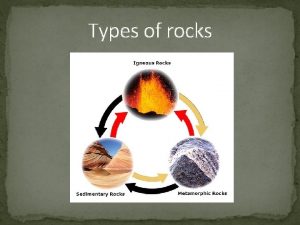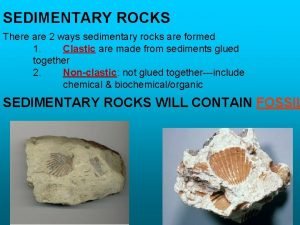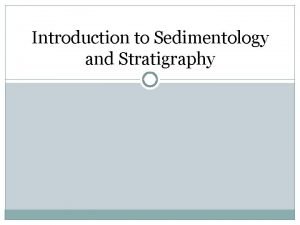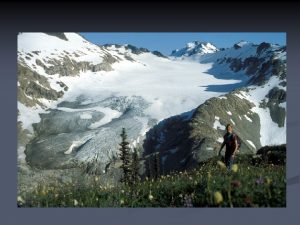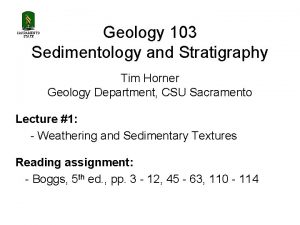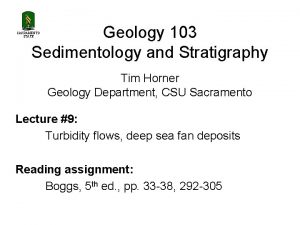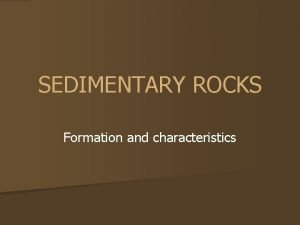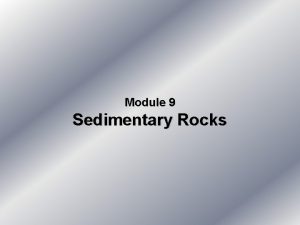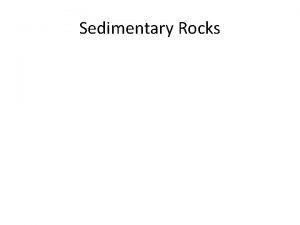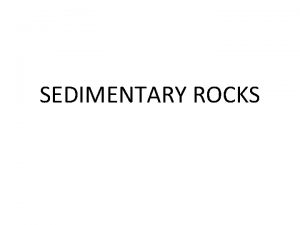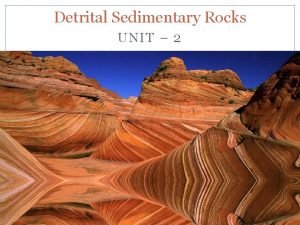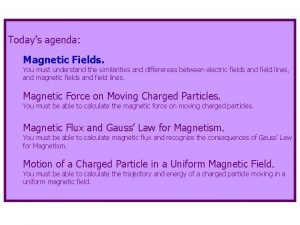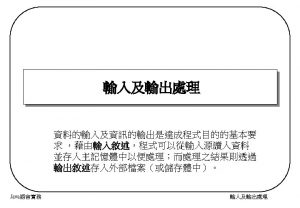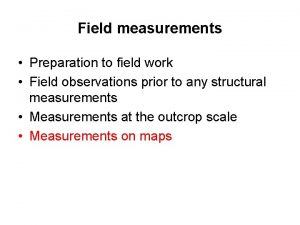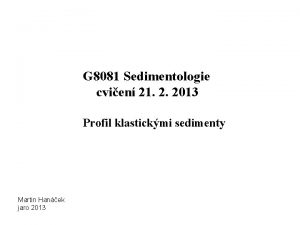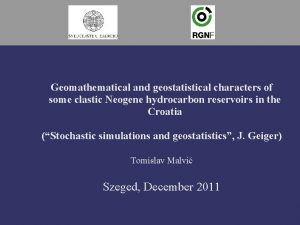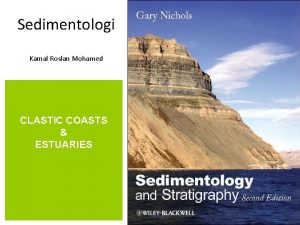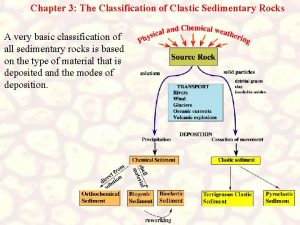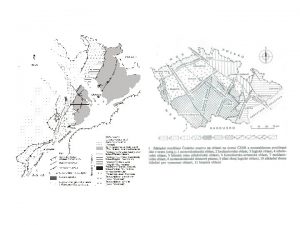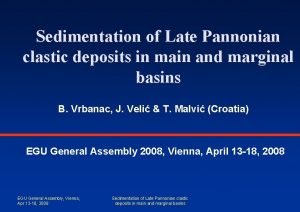G 8081 Sedimentology field work Description of clastic

















- Slides: 17

G 8081 Sedimentology (field work) Description of clastic sediments Martin Hanáček, Marek Goldbach jaro 2013

Practical lesson outline Sedimentary profile analysis (profile will be specified) 1) Deposits description: (textures, struktures, layer thickness, mineralogy…). 2) Personal field notes preparations 3) Final work has to be finished in Corel, or other relevant aplication 4) Profile interpretation. 5) Final has to be sent via email.

Clastic deposits research step by step 1) Localisation (GPS, map), photo documentation 2) Distinction of sediments (pelites, aleurites, psamites a psefites). 3) Shape and description of each sedimentary layer bases (narow base, through, transtions changes, vertical changes between each layers, lateral stables or through, thickness). Later, procedure differ in coarse grained and fine grained deposits. Psaamite, aleurite and pelite deposit body 1. Shape of each sets buil whole body (horizontal base, through base etd. ), sets thickness. Term sers means each body which include inner bedding. Whole sedimentary bedding may be built by one ore more sets. 2. Type of bedding, thickness of beds or lamines in every sets Psefitic body 1) Prevailing fraction (granules, pebbles, cobbles, boulders). 2) Sorting 3) Bedding type (if presented) 4) Meassuring of few biggest clasts 5) Clast supported structures or matrix supported structures. 6) Gravel clasts orientation in sediments 7) Roudnes of clastics material 8) Petrografy of deposition materials Roudnes – portion of each cathegory in %. On outcroop is neccesary mark sqare (0, 5 -1 m) in which marking of all visible clasts is neccesry. Resuls are finalised in bar chart Petrography – in the some square determine of clasts. Results are presented in pie chart. Never také out clasts from conglomerates. Work just on those, which are visible. Use meter as a scale if taking picture. Picture withnout cant be used.

Clasification of clastics sediments

Character of bases: flat bases through bases (scour structures) Shape of sedimentary units: lateraly large extend units, lateraly terminate units, thickness of units.

a) Planar cross bedding (lamination) – straight and flat or slighly inclined bases of sets. Bedding (lamination) is inclined below high angle for bases. b) Trough cross bedding (lamination) – Trough cut-off bases and confomably curved bedding (lamnation)

Cross bedding deltaic foresets - large thickness – large thickness. Horizontal bedding (lamination) Occurs on aleurite, psamite and psephite.

Psefites granulometry Granules: 2 -4 mm Pebbles: 4 -64 mm Cobbles: 64 -256 mm Boulders: nad 256 mm Macroscopic estimation of volume particals in dektop (may be used for assesment of share most coarse clastics in sediments We have measure larges clasts or a lot of other larges clasts as well as average and most common size. Axis of clasts A-axis – longest B-axis – middle C-axis - briefest

Sorting Sorted conglomerate Unsorted conglomerate

Bedding of psephite a) Horizontal bedding b) Inclined bedding c) Planar cross bedding and trough cross bedding d) Masive structure (unstratification) Difference between inclined and cross bedding is mesured on bow of layers. Inclined bedding is under 34°. This is valid for all clastics sediments.

Inclined bedding Masive structure, on uppermost part of section is horizontal bedding.

Clast supported structure (a, b, c) Gravelly clasts on contact each other. Matrix supported structure (d) Gravelly clasts not contact each other, individual clasts are among by finegrained matrix. Inverze grading Sediment coarsering from base to top. Normal grading Sediment fining from base to top.

Clasts fabrics: orientation according face, defined by a-axis and b-axis. Horizontal or inclined orientation parallel with flow. Imbrication – oriented against flow.

Large clasts are flat bedded and oriented parallel with flow. Clast supported and matrix supported. Both types of structurs alternate within psephites.

Roudness Shape Isometric (sphere or kubic) A-axis = B-axis = C-axis Rod A-axis is dominant, B and C-axis are distinctively shorter. Blade A-axis is dominant, B-axis any shorter, C-axis is clear briefest. Diskovitý A-axis = B-axis, c-axis clear briefest. Subrounded clasts Angular and very angular clasts.

Profile drawing Main bodies can be marked by number, however it is not neccesary. Lithifacies can be marked by codes. Please use types, which are in picture. Facies – sediments which can be charakterised by specific sign what is different from deposits in overlies and underlies Lithofacies – lithological character signes, in our case layering

Použitá literatura Collinson J. , Mountney N. , Thompson D. (2006): Sedimentary structures. – 292 pp. , Terra Publishing, 3. vydání. Evans D. , J. A. , Benn D. J. I. (2004): A Practical Guide to the Study of Glacial Sediments. – 266 pp. , Arnold. Tucker M. (2003): Sedimentary rocks in the field – John Wiley, 3. vydání
 How is a metamorphic rock formed
How is a metamorphic rock formed What are 2 ways sedimentary rocks form
What are 2 ways sedimentary rocks form Clastic vs non clastic
Clastic vs non clastic Clastic vs non clastic
Clastic vs non clastic Cignaforhcp
Cignaforhcp What are sediments
What are sediments Sedimentology
Sedimentology Sac state geology
Sac state geology Sedimentology
Sedimentology What are sedimentary rocks
What are sedimentary rocks Sedimentary rocks characteristics
Sedimentary rocks characteristics Clastic sedimentary rocks
Clastic sedimentary rocks What kind of sedimentary rock is coal
What kind of sedimentary rock is coal Sedimentary rock
Sedimentary rock Clastic chemical and biochemical sedimentary rocks
Clastic chemical and biochemical sedimentary rocks Sedimentary igneous rocks
Sedimentary igneous rocks Detrital sediment
Detrital sediment Magnitude of magnetic force
Magnitude of magnetic force
